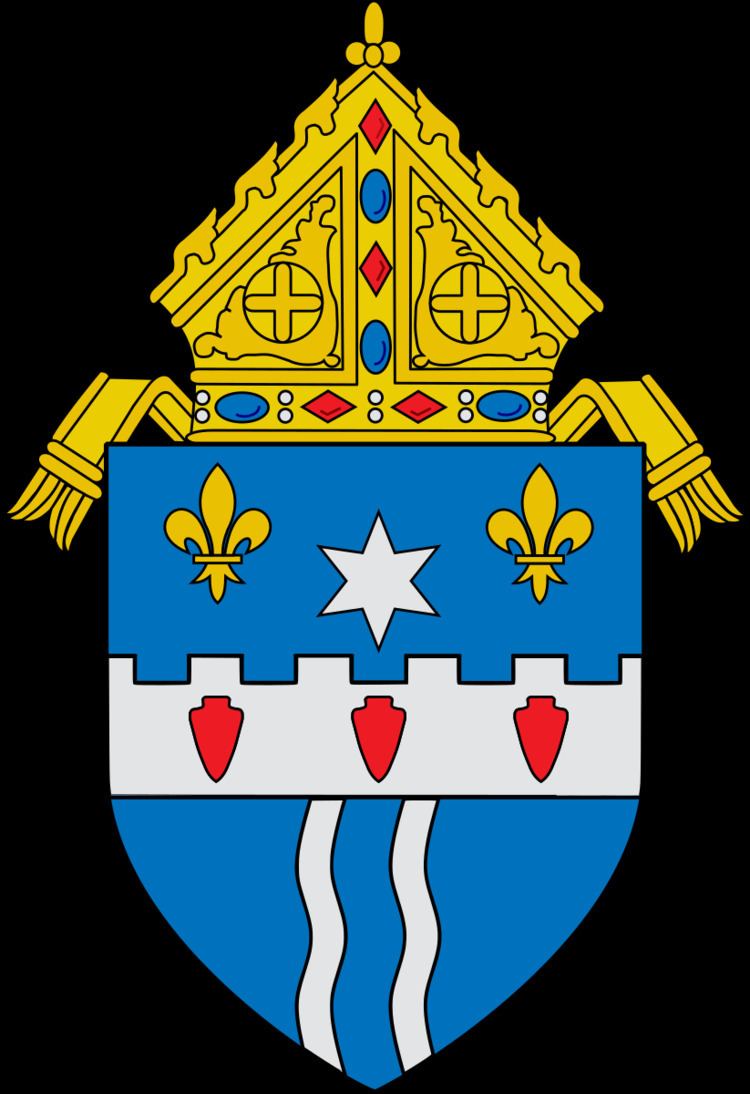Population- Catholics 218,000 (17.7%) Phone +1 502-585-3291 | Denomination Roman Catholic Established April 8, 1808 Ecclesiastical province Louisville | |
 | ||
Address 212 E College St, Louisville, KY 40203, USA Hours Closed now Tuesday8:30AM–4:30PMWednesday8:30AM–4:30PMThursday8:30AM–4:30PMFriday8:30AM–4:30PMSaturdayClosedSundayClosedMonday8:30AM–4:30PMSuggest an edit Similar Trinity High School Marshall, Cathedral of the Assumpti, St James Church, St Louis Bertrand Catholic, JCPS Van Hoose Center Profiles | ||
The Roman Catholic Archdiocese of Louisville consists of twenty-four counties in central Kentucky, US, covering 8,124 square miles (21,040 km2). It is the seat of the Metropolitan Province of Louisville, which comprises the states of Kentucky and Tennessee. The cathedral church of the archdiocese is the Cathedral of the Assumption.
Contents
History
The Diocese began in 1808 when the Roman Catholic Diocese of Bardstown centered in Bardstown, Kentucky, which was then a thriving frontier settlement. It was established along with the dioceses of Boston, New York, and Philadelphia by Pope Pius VII, (1742–1823, served 1800–1823), out of the territory of the Diocese of Baltimore, the first Catholic diocese in the United States, which was first "erected" (established) in 1789 with the first bishop in the U.S.A., John Carroll, who was ordained/consecrated in Britain in 1790. Pope Benedict XVI's visit to the U.S. in April 2008 celebrated the 200th anniversary of the creation of these wider dioceses and the elevation of Baltimore to an archdiocese (known as "The Premier See"). When founded, the Bardstown Diocese included most of the new states of Kentucky, Tennessee, Missouri, Illinois, Indiana, Ohio, and Michigan—the western territories of America to the Mississippi River and the Louisiana Purchase of 1803.
While Louisville is the oldest inland diocese in the United States, it is not the oldest west of the Appalachians. That distinction belongs to the Roman Catholic Archdiocese of New Orleans founded under Spanish rule in 1793, and which territory as part of the Louisiana Purchase became a part of the U.S.A. in 1803, and Louisiana admitted as a state in 1812.
Benedict Joseph Flaget was the first Bishop of Bardstown. The historic Basilica of Saint Joseph Proto-Cathedral, the former cathedral of the Diocese of Bardstown, is now a parish church, and a national historic site.
While the French may have had initial influence in the formation of the Roman Catholic community in the Louisville area, eventually immigrants from Germany comprised the bulk of the Archdiocese's communicant strength later in the mid-19th century, particularly in the city of Louisville. However, much of the Catholic population in areas southeast of Louisville is of English extraction, consisting of descendants of recusants who originally settled in Maryland in colonial times.
In 1841, the diocese was moved from Bardstown to Louisville, becoming the Diocese of Louisville. The Diocese of Louisville was elevated in 1937 to become the Archdiocese of Louisville, and the "metropolitan" (supervising) province for all the dioceses in Kentucky and Tennessee with an Archbishop of Louisville. There are currently three deaneries: Elizabethtown, Lebanon, and Bardstown.
Statistics
The archdiocese contains 200,000 Catholics in 66,000 households, served by one hundred twenty-two parishes and missions. One half of all Catholics in the Commonwealth reside within the bounds of the Archdiocese of Louisville, and seventy-nine percent of all Catholics in the archdiocese (forty percent of all Catholics in the Commonwealth) reside in the Louisville Metro area. There are fifty-nine Catholic elementary and high schools serving more than 23,400 students. The archdiocese is home to one hundred sixty-six diocesan priests, one hundred twelve permanent deacons, fifty-two religious institute priests, seventy-seven religious brothers, and nine hundred forty-four religious sisters. The archdiocese serves more than 220,000 persons in Catholic hospitals, health care centers, homes for the aged, and specialized homes. Services, mother-infant care program, senior social services, and rural ministries services.
Sex abuse scandal
In 2003, the Archdiocese of Louisville paid $25.7 million directly from its own assets to settle claims of sexual abuse by its clergy. Reports of abuse extended back to the 1940s, were alleged to have continued to 1997, and involved 34 priests, two religious brothers, and three lay people.
Archbishops and bishops
The lists of ordinaries and their years of service:
Bishops
- Benedict Joseph Flaget, S.S. (1808–1832) resigned
- John Baptist Mary David, S.S. (1832–1833) succeeded
- Benedict Joseph Flaget, S.S. (1833–1850) died
- Martin John Spalding (1850–1864) appointed Archbishop of Baltimore
- Peter Joseph Lavialle (1865–1867) died
- William George McCloskey (1868–1909) died
- Denis O'Donaghue (1910–1924) retired
- John A. Floersh (1924–1937) elevated to Archbishop
Archbishops
- John A. Floersh (1937–1967) retired
- Thomas Joseph McDonough (1967–1981) resigned
- Thomas Cajetan Kelly, O.P (1981–2007) retired
- Joseph Edward Kurtz (2007–present)
Past and present affiliated bishops
High schools
Ten Catholic secondary schools serve more than 6,300 students. Eight of the schools are located in Jefferson County and one in Nelson County. Four of the schools enroll only girls, three enroll only boys, and two are coeducational.
Boys
Girls
Coeducational
Other
Elementary schools
Forty Catholic parish, regional, and special elementary schools serve more than 15,500 students in seven counties of the Archdiocese of Louisville.
Metropolitan Province of Louisville
The Metropolitan Province of Louisville covers the states of Kentucky and Tennessee, and comprises the following dioceses:
